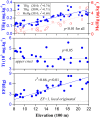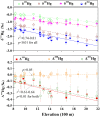Atmospheric mercury inputs in montane soils increase with elevation: evidence from mercury isotope signatures
- PMID: 24270081
- PMCID: PMC3839031
- DOI: 10.1038/srep03322
Atmospheric mercury inputs in montane soils increase with elevation: evidence from mercury isotope signatures
Abstract
The influence of topography on the biogeochemical cycle of mercury (Hg) has received relatively little attention. Here, we report the measurement of Hg species and their corresponding isotope composition in soil sampled along an elevational gradient transect on Mt. Leigong in subtropical southwestern China. The data are used to explain orography-related effects on the fate and behaviour of Hg species in montane environments. The total- and methyl-Hg concentrations in topsoil samples show a positive correlation with elevation. However, a negative elevation dependence was observed in the mass-dependent fractionation (MDF) and mass-independent fractionation (MIF) signatures of Hg isotopes. Both a MIF (Δ(199)Hg) binary mixing approach and the traditional inert element method indicate that the content of Hg derived from the atmosphere distinctly increases with altitude.
Figures





References
-
- Schroeder W. H. & Munthe J. Atmospheric mercury - An overview. Atmos. Environ. 32, 809–822 (1998).
-
- Zhang H., Feng X., Larssen T., Shang L. & Li P. Bioaccumulation of Methylmercury versus Inorganic Mercury in Rice (Oryza sativa L.) Grain. Environ. Sci. Technol. 44, 4499–4504 (2010). - PubMed
-
- Sommar J., Zhu W., Lin C.-J. & Feng X. Field approaches to measure mercury exchange between natural surfaces and the atmosphere–a review. Cri. Rev.Env. Sci. Tec. 43, 1657–1739 (2013).
-
- Holmes C. D. et al. Global atmospheric model for mercury including oxidation by bromine atoms. Atmo. Chem. Phys. 10, 12037–12057 (2010).
Publication types
LinkOut - more resources
Full Text Sources
Other Literature Sources
Molecular Biology Databases
Miscellaneous

